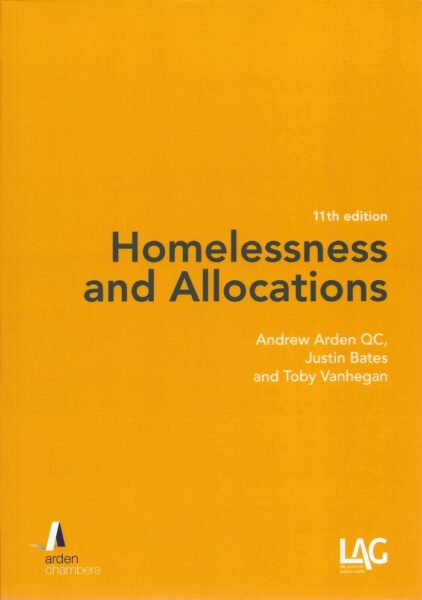New edition of 'Homelessness and Allocations' published
Hot on the heel's of last year's tenth edition, a new edition of Legal Action Group's 'Homelessness and Allocations' has just been published.

Written by Andrew Arden QC, Justin Bates and Toby Vanhegan of Arden Chambers, its 15 chapters provide a comprehensive (but concise) explanation of the law governing the allocation of social housing and the homelessness safety net.
In addition to commentary on the legal provisions there are appendices that reproduce the legislation, regulations and statutory guidance.
The book therefore provides a one-stop resource for practitioners. You need go no further if you need to check the rules or how the courts have interpreted the rules. Or indeed how the Secretary of State suggests you should interpret the legislation.
Instead of merely updating the tenth edition by just including the new statutory guidance and Review Regulations the authors have instead chosen to revisit the text.
Worth it?
So is it worth buying the eleventh edition if you bought the last edition just a few months ago?
Well, as one would expect the structure and contents are very similar.
What case law there has been in the last twelve months is of course incorporated, including the recent post-Hotak cases in the Court of Appeal on vulnerability.
Some sections have noticeably benefited from being revisited, for example the explanations of how the interim accommodation and relief duties come to an end.
I get the impression the authors welcomed an opportunity to further refine their description of the legal duties, particularly those arising in relation to 'new' homeless applications, i.e. those made on or after 3rd April 2018.
The result is a subtle but significant improvement in how various aspects of the homelessness process are treated. Even Toby Vanhegan's excellent chapter on the law governing eligibility for housing on immigration grounds - which I expected to have hardly changed - has been amended.
Undoubtedly the text benefits from the authors being able to describe the law as it is, rather than what it will be (post-Homelessness Reduction Act 2017).
Making sense of complexity
The authors routinely point out where general rules are subject to exceptions, including where the two different statutory frameworks governing homeless applications come into play (i.e. in respect of pre and post-3rd April applications).
While sometimes I'm left hankering for the simplicity of, say the fourth edition, this is simply the result of how homelessness law has become more complex and the plethora of reported court judgments, rather than because of any shortcomings on the authors' part.
In fact the authors do a sterling job of making a complex subject easily accessible, whether you're a newcomer or old hand. Their mastery of the subject is illustrated by Chapter 12's summary of the public law grounds on which allocation and homelessness decisions can be challenged. This section is essential reading for housing officers who want to make good decisions. For lawyers the same chapter includes a summary of the procedural rules governing section 204 appeals and applications for judicial review, and provides precedent letters and forms.
One of the book's strengths is how current provisions are placed in their historical context. Government policy and case law is often explained by reference to what has gone before. This is unsurprising given that Andrew Arden has been involved in many of the leading cases since the early 1980s.
Formats
The text is available as a book (available now) and e-book (available this Friday). And there's a 'bundle' which includes both.
Wales
The law in Wales is covered as well as the English position (as with most of LAG's housing books). This makes sense given that the legal frameworks for both allocations and homelessness are very similar each side of the border.
However, don't assume there's any Welsh case law to help you interpret the homelessness changes in England. The absence of any higher court cases in the principality has continued since Part 2 of the Housing (Wales) Act 2014 came into force in April 2015.
The electronic version includes the Welsh guidance and statutory instruments while the standard paper version does not.
However, the publishers bring an innovation with this edition, specifically for those who want all the Welsh materials in hard copy. For the first time there's also a Welsh paper version, that for £15 more includes the Welsh guidance and regulations. This version is very chunky indeed. Which is unsurprising given there's 400 extra pages and the page size is relatively small (about six by eight inches).
It can be ordered now and copies will be shipped from next week. However a limited number will be available.
Grumble
If I do have a criticism it's about Legal Action Group's decision to no longer provide their titles in pdf format.
I mentioned this when reviewing the previous edition. At the risk of repeating myself, an e-book really is a very poor substitute. Personally I want the ability to search a pdf, particularly when I'm busy and want to locate something quickly.
Consequently I'm more likely to reach for the other book on allocations and homelessness when I'm at my pc or laptop (of which a new edition is published next month).
This is a real shame because Arden, like the other LAG housing texts, remains an essential purchase.
Posted in category: Housing allocation Books & publications
Comments